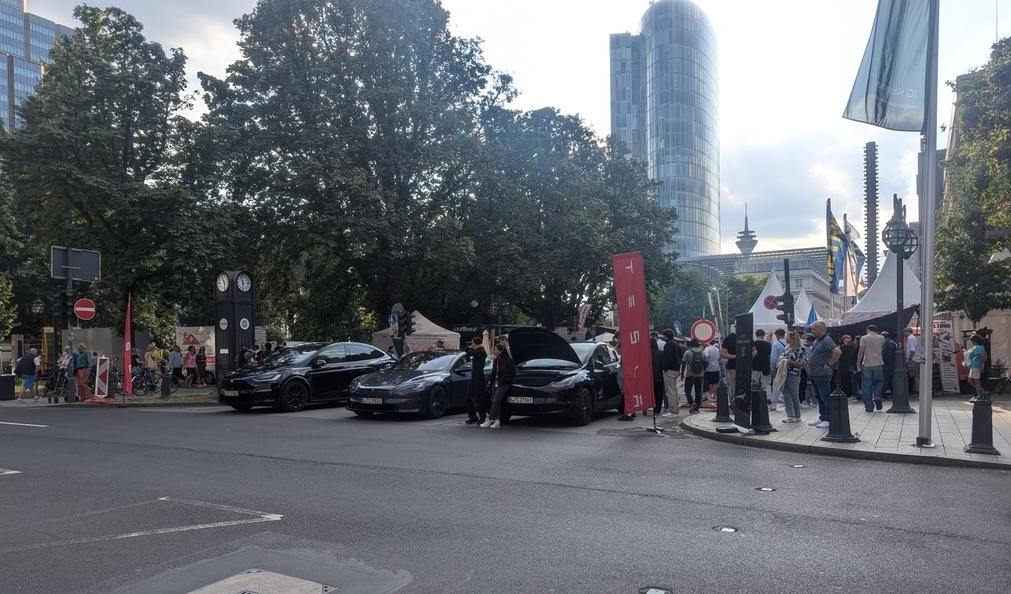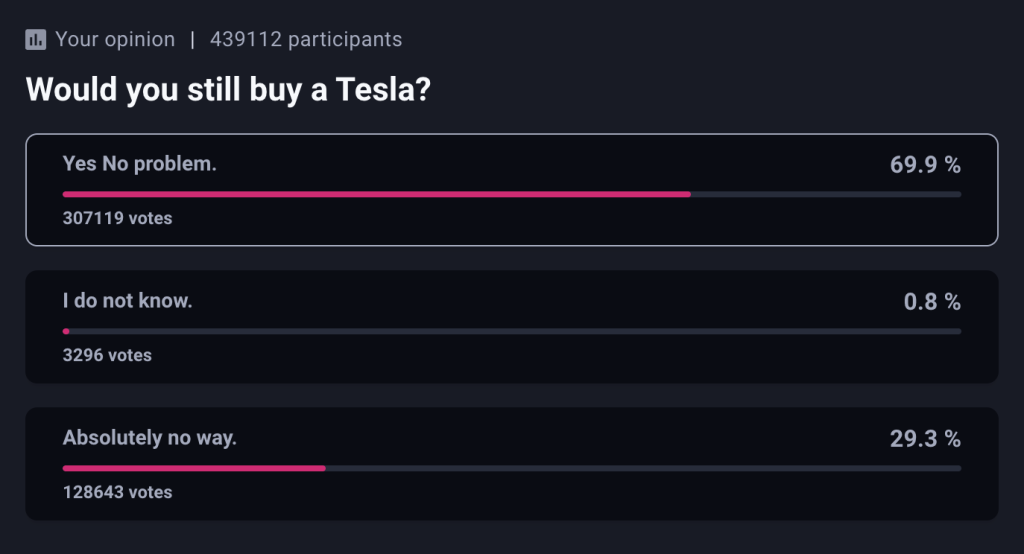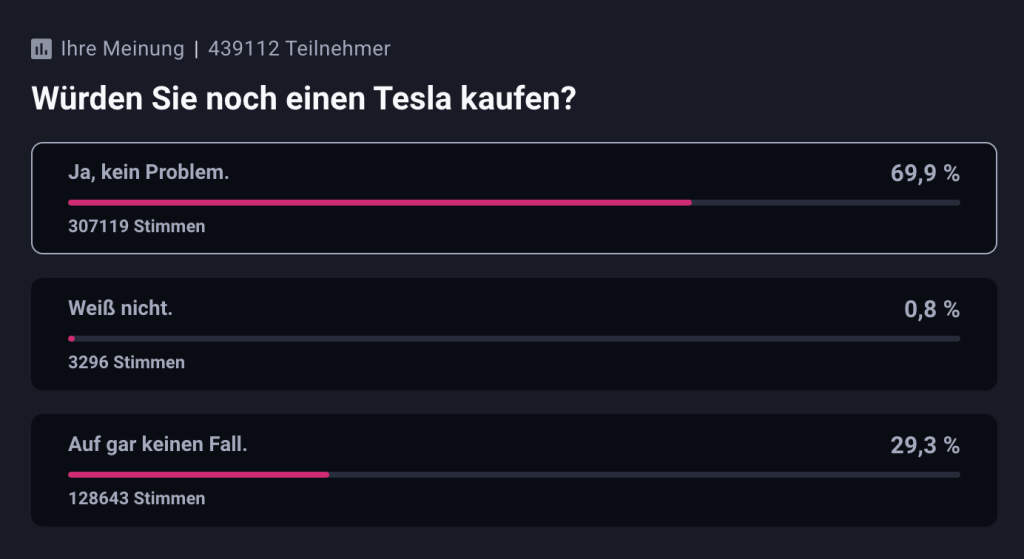News
Tesla is NOT done in Germany–exact same poll debunks its own “94% won’t buy Tesla” narrative
As of writing, 307,119 readers, or 69.9% of the study’s overall respondents, stated that they would still buy a Tesla.

As it turns out, news of Tesla’s demand death in Germany have been widely exaggerated. This is highlighted by the same poll that was used to frame the narrative that 94% of car buyers will not buy a Tesla in Germany.
So no, Tesla is not done in Germany. Nowhere close.
The Survey and the Reports
A look at the Tesla news cycle over the past few days would show that one of the biggest stories about the electric vehicle maker involved the results of a survey from German publication t-online. As per the reports, a survey of over 100,000 t-online readers has shown that 94% were not willing to buy a Tesla, and only a minuscule 3% were still willing to consider a vehicle from the American EV maker.
t-online’s report on its survey, as well as articles that cited the study, related the alleged drop in Tesla interest in Germany to Elon Musk’s conservative politics. However, the survey itself received polarizing reactions among social media users since its respondents were self-selected. The poll also seemed open to everyone globally, so its results may not have been the most accurate.
These concerns, of course, were largely ignored and dismissed as the complaints of Tesla “cult” members or “stans,” as critics stated on social media. Unfortunately for Elon Musk/Tesla critics, it appears that t-online‘s Tesla poll is not done telling its story just yet.
Ongoing Survey, Drastically Different Results
While t-online published its article about Tesla’s alleged decline in Germany after the study passed 100,000 responses, the survey itself was actually left open. Thus, despite articles stating that Tesla is done in Germany already spreading online, t-online’s survey was still gathering data from respondents. Interestingly enough, the survey started showing a drastically different narrative once it started getting more respondents.
As of writing, a total of 439,111 respondents have participated in t-online’s Tesla survey. As of writing, 307,119 readers, or 69.9% of the study’s overall respondents, stated that they would still buy a Tesla. A total of 128,643 readers, or 29.3% of the study’s respondents, stated that they would “absolutely no way” consider a Tesla. A total of 3,296 t-online readers, or 0.8% of the survey’s current respondents, stated that they “do not know” if they would like to buy a Tesla.


Keeping Things in Perspective
While one could argue that the current findings of the survey are probably astroturfed by Tesla “stans” or “cult” members, the fact remains that the poll itself was flawed to begin with. Its self-selected respondents could have been affected by bias, and the fact that it seemed open to all users across the globe suggests that the study may not have accurately represented Germany’s car buying public at all.
With this in mind, it would be unreasonable to argue that t-online‘s poll was completely accurate up to its first 100,000 respondents but inaccurate when more respondents answered the survey. The reports that emerged from the first 100,000 respondents of the poll concluded that Tesla was finished in Germany. Following the same logic, one could argue that such reports were premature, and based on updated data from the same survey, Tesla still enjoys majority support in Germany.

News
Tesla starts showing how FSD will change lives in Europe
Local officials tested the system on narrow country roads and were impressed by FSD’s smooth, human-like driving, with some calling the service a game-changer for everyday life in areas that are far from urban centers.

Tesla has launched Europe’s first public shuttle service using Full Self-Driving (Supervised) in the rural Eifelkreis Bitburg-Prüm region of Germany, demonstrating how the technology can restore independence and mobility for people who struggle with limited transport options.
Local officials tested the system on narrow country roads and were impressed by FSD’s smooth, human-like driving, with some calling the service a game-changer for everyday life in areas that are far from urban centers.
Officials see real impact on rural residents
Arzfeld Mayor Johannes Kuhl and District Administrator Andreas Kruppert personally tested the Tesla shuttle service. This allowed them to see just how well FSD navigated winding lanes and rural roads confidently. Kruppert said, “Autonomous driving sounds like science fiction to many, but we simply see here that it works totally well in rural regions too.” Kuhl, for his part, also noted that FSD “feels like a very experienced driver.”
The pilot complements the area’s “Citizen Bus” program, which provides on-demand rides for elderly residents who can no longer drive themselves. Tesla Europe shared a video of a demonstration of the service, highlighting how FSD gives people their freedom back, even in places where public transport is not as prevalent.
What the Ministry for Economic Affairs and Transport says
Rhineland-Palatinate’s Minister Daniela Schmitt supported the project, praising the collaboration that made this “first of its kind in Europe” possible. As per the ministry, the rural rollout for the service shows FSD’s potential beyond major cities, and it delivers tangible benefits like grocery runs, doctor visits, and social connections for isolated residents.
“Reliable and flexible mobility is especially vital in rural areas. With the launch of a shuttle service using self-driving vehicles (FSD supervised) by Tesla in the Eifelkreis Bitburg-Prüm, an innovative pilot project is now getting underway that complements local community bus services. It is the first project of its kind in Europe.
“The result is a real gain for rural mobility: greater accessibility, more flexibility and tangible benefits for everyday life. A strong signal for innovation, cooperation and future-oriented mobility beyond urban centers,” the ministry wrote in a LinkedIn post.
News
Tesla China quietly posts Robotaxi-related job listing
Tesla China is currently seeking a Low Voltage Electrical Engineer to work on circuit board design for the company’s autonomous vehicles.

Tesla has posted a new job listing in Shanghai explicitly tied to its Robotaxi program, fueling speculation that the company is preparing to launch its dedicated autonomous ride-hailing service in China.
As noted in the listing, Tesla China is currently seeking a Low Voltage Electrical Engineer to work on circuit board design for the company’s autonomous vehicles.
Robotaxi-specific role
The listing, which was shared on social media platform X by industry watcher @tslaming, suggested that Tesla China is looking to fill the role urgently. The job listing itself specifically mentions that the person hired for the role will be working on the Low Voltage Hardware team, which would design the circuit boards that would serve as the nervous system of the Robotaxi.
Key tasks for the role, as indicated in the job listing, include collaboration with PCB layout, firmware, mechanical, program management, and validation teams, among other responsibilities. The role is based in Shanghai.
China Robotaxi launch
China represents a massive potential market for robotaxis, with its dense urban centers and supportive policies in select cities. Tesla has limited permission to roll out FSD in the country, though despite this, its vehicles have been hailed as among the best in the market when it comes to autonomous features. So far, at least, it appears that China supports Tesla’s FSD and Robotaxi rollout.
This was hinted at in November, when Tesla brought the Cybercab to the 8th China International Import Expo (CIIE) in Shanghai, marking the first time that the autonomous two-seater was brought to the Asia-Pacific region. The vehicle, despite not having a release date in China, received a significant amount of interest among the event’s attendees.
Elon Musk
Elon Musk and Tesla AI Director share insights after empty driver seat Robotaxi rides
The executives’ unoccupied tests hint at the rapid progress of Tesla’s unsupervised Robotaxi efforts.

Tesla CEO Elon Musk and AI Director Ashok Elluswamy celebrated Christmas Eve by sharing personal experiences with Robotaxi vehicles that had no safety monitor or occupant in the driver’s seat. Musk described the system’s “perfect driving” around Austin, while Elluswamy posted video from the back seat, calling it “an amazing experience.”
The executives’ unoccupied tests hint at the rapid progress of Tesla’s unsupervised Robotaxi efforts.
Elon and Ashok’s firsthand Robotaxi insights
Prior to Musk and the Tesla AI Director’s posts, sightings of unmanned Teslas navigating public roads were widely shared on social media. One such vehicle was spotted in Austin, Texas, which Elon Musk acknowleged by stating that “Testing is underway with no occupants in the car.”
Based on his Christmas Eve post, Musk seemed to have tested an unmanned Tesla himself. “A Tesla with no safety monitor in the car and me sitting in the passenger seat took me all around Austin on Sunday with perfect driving,” Musk wrote in his post.
Elluswamy responded with a 2-minute video showing himself in the rear of an unmanned Tesla. The video featured the vehicle’s empty front seats, as well as its smooth handling through real-world traffic. He captioned his video with the words, “It’s an amazing experience!”
Towards Unsupervised operations
During an xAI Hackathon earlier this month, Elon Musk mentioned that Tesla owed be removing Safety Monitors from its Robotaxis in Austin in just three weeks. “Unsupervised is pretty much solved at this point. So there will be Tesla Robotaxis operating in Austin with no one in them. Not even anyone in the passenger seat in about three weeks,” he said. Musk echoed similar estimates at the 2025 Annual Shareholder Meeting and the Q3 2025 earnings call.
Considering the insights that were posted Musk and Elluswamy, it does appear that Tesla is working hard towards operating its Robotaxis with no safety monitors. This is quite impressive considering that the service was launched just earlier this year.








